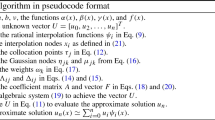Abstract
In the previous work of this author (Bieniasz in Computing 83:25–39, 2008) an adaptive numerical method for solving the first kind Abel integral equation was described. It was assumed that the starting value of the solution was known and equal zero. This is a frequent situation in some applications of the Abel equation (for example in electrochemistry), but in general the starting solution value is unknown and non-zero. The presently described extension of the method allows one to automatically determine both the starting solution value and the estimate of its discretisation error. This enables an adaptive adjustment of the first integration step, to achieve a pre-defined accuracy of the starting solution. The procedure works most satisfactorily in cases when the solution possesses all, or at least several of the lowest, derivatives at the initial value of the independent variable. Otherwise, a discrepancy between the true and estimated errors of the starting solution value may occur. In such cases one may either start integration with as small step as possible, or use a smaller error tolerance at the first step.
Similar content being viewed by others
Explore related subjects
Discover the latest articles, news and stories from top researchers in related subjects.References
Baker CTH (1977) The numerical treatment of integral equations. Clarendon Press, Oxford
Bieniasz LK (1992) ELSIM-A user-friendly PC program for electrochemical kinetic simulations. Version 1.0-solution of integral equations for linear scan and cyclic voltammetry. Comput Chem 16: 11–14
Bieniasz LK (1993) An efficient numerical method of solving integral equations for cyclic voltammetry. J Electroanal Chem 347: 15–30
Bieniasz LK (2008) An adaptive Huber method with local error control, for the numerical solution of the first kind Abel integral equation. Computing 83: 25–39
Britz D (2005) Digital simulation in electrochemistry, 3rd edn. Springer, Berlin
Brunner H (1974) Global solution of the generalized Abel integral equation by implicit interpolation. Math Comput 28: 61–67
Cody WJ (1969) Rational Chebyshev approximations for the error function. Math Comput 23: 631–637
Gorenflo R, Vessella S (1991) Abel integral equations. Lect Notes Math 1461: 1–215
Gustafsson K (1994) Control-theoretic techniques for stepsize selection in implicit Runge-Kutta methods. ACM Trans Math Softw 20: 496–517
Huber A (1939) Eine Näherungsmethode zur Auflösung Volterrascher Integralgleichungen. Monatsschr Math Phys 47: 240–246
Lovrić M (1996) Simulation of electrochemical problems by numerical integration. Russ J Electrochem 32: 988–995
Mirkin MV, Nilov AP (1991) Modification of the Huber method for solving integral equations on a non-uniform grid. Comput Chem 15: 55–58
Nicholson RS, Shain I (1964) Theory of stationary electrode polarography, single scan and cyclic methods applied to reversible, irreversible, and kinetic systems. Anal Chem 36: 706–723
Nicholson RS, Olmstead ML (1972) Numerical solution of integral equations. In: Mattson JS Jr, Mark HB Jr, MacDonald HC Jr (eds) Computers in chemistry and instrumentation, vol 2. Electrochemistry, calculations, simulation, and instrumentation. Marcel Dekker, New York, pp 119–138
Author information
Authors and Affiliations
Corresponding author
Rights and permissions
About this article
Cite this article
Bieniasz, L.K. Initialisation of the adaptive Huber method for solving the first kind Abel integral equation. Computing 83, 163–174 (2008). https://doi.org/10.1007/s00607-008-0020-9
Received:
Accepted:
Published:
Issue Date:
DOI: https://doi.org/10.1007/s00607-008-0020-9
Keywords
- The first kind Abel integral equations
- Adaptive methods
- A posteriori error estimation
- Product-integration
- Huber method
- Computational electrochemistry



